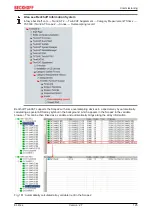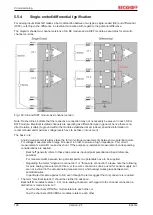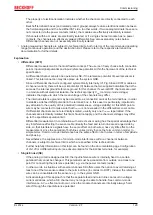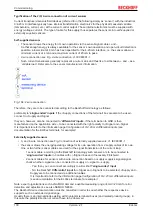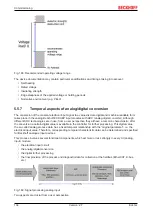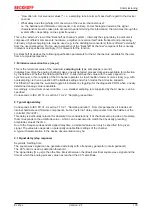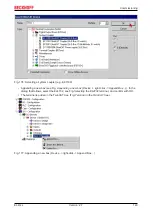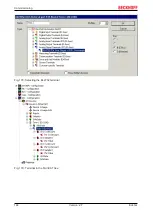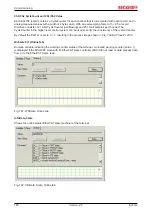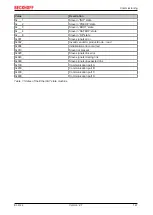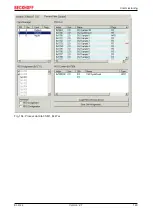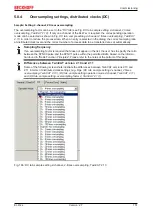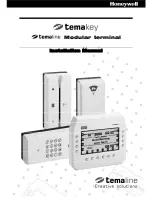
Commissioning
EL47xx
138
Version: 2.7
The EL47xx may be set to oversampling n = 10 in the TwinCAT System Manager. This causes the ESC to
generate a second interrupt in the terminal with an n-times higher frequency, in this case 10 kHz or 100 µs
period. This interrupt is called SYNC0. With each SYNC0 signal the output voltage is transferred to the DAC
(digital to analog converter) as a digital value.
Voltage output
Both output voltages (channels 1 and 2) are always output simultaneously. This is ensured by the
DAC type that is triggered by the SYNC0 pulse. No other operation mode is possible.
Generation of the SYNC0 pulse from the local synchronized clock within the distributed clock network
ensures that the analog values are sampled at highly equidistant intervals with the period of the SYNC1
pulse.
The maximum oversampling factor depends on the memory size of the ESC. In the EL47xx it is n = 100.
Maximum sampling frequency
A smaller period than 10 µs is not permitted for the EL47xx. The maximum sampling frequency for
the EL47xx is therefore 100 kSps (samples per second).
Regarding the calculation of SYNC0 from the SYNC1 pulse based on manual specification of an
oversampling factor, please note that for SYNC0 only integer values are calculated at nanosecond
intervals.
Sample: 187,500 µs is permitted, 333.3 is not.
Sample:
For SYNC1 = 1 ms oversampling factors such as 1,2,5 or 100 are permitted, but not 3. If implausible values
are used the terminal will still reach the OP state but will not output correct process data. This may result in a
working counter error.
With 2 channels and n = 100, 2 x 2 x 100 = 400 bytes of process data must be transferred to the EL47xx
during each EtherCAT cycle.
Working with DC times in the controller
From the perspective of the controller the distributed clock time has the following characteristics:
• Unit
1 ns
• Universal zero point
1.1.2000 00:00
, i.e. for variable evaluations an offset of 2000 years has to be
added
• Scope up to
64 bit
(sufficient for 584 years). However, some EtherCAT slaves only support a 32 bit
scope, i.e. the register overflows locally after approx. 4.2 seconds and starts again at 0.
The following 3 data types are recommended for handling DC times
•
T_DCTIME
from TcEtherCAT.lib
This is based on T_ULARGE_INTEGER and is therefore unsigned. It can be used for linking with
suitable hardware variables
•
T_ULARGE_INTEGER
from TcUtilities.lib
Unsigned 64-bit data type
•
T_LARGE_INTEGER
from TcUtilities.lib
Signed 64-bit data type, negative numbers are represented in two's complement notation (underflow
below 0 --> 0xFFFF FFFF FFFF FFFF etc.)
TcUtilities.lib (section INT64) provides numerous relevant functions. Of particular significance are the
cast functions LARGE_TO_ULARGE and vice versa.
This type should be used when working with time differences that may be negative.
If TwinCAT is used for external synchronization, negative times will inevitably occur in the offset values.
Содержание EL47 Series
Страница 1: ...Documentation EL47xx Analog output terminal with oversampling 2 7 2020 02 27 Version Date...
Страница 2: ......
Страница 33: ...Mounting and wiring EL47xx 33 Version 2 7 Fig 23 Other installation positions...
Страница 70: ...Commissioning EL47xx 70 Version 2 7 Fig 73 Incorrect driver settings for the Ethernet port...
Страница 81: ...Commissioning EL47xx 81 Version 2 7 Fig 92 EtherCAT terminal in the TwinCAT tree left TwinCAT 2 right TwinCAT 3...
Страница 144: ...Commissioning EL47xx 144 Version 2 7 Fig 178 Selecting the EL4732 terminal Fig 179 Terminal in the TwinCAT tree...
Страница 149: ...Commissioning EL47xx 149 Version 2 7 Fig 184 Process data tab SM1 EL47xx...
Страница 156: ...Commissioning EL47xx 156 Version 2 7 Fig 195 Process Data tab adaptation of process data in SM0...


